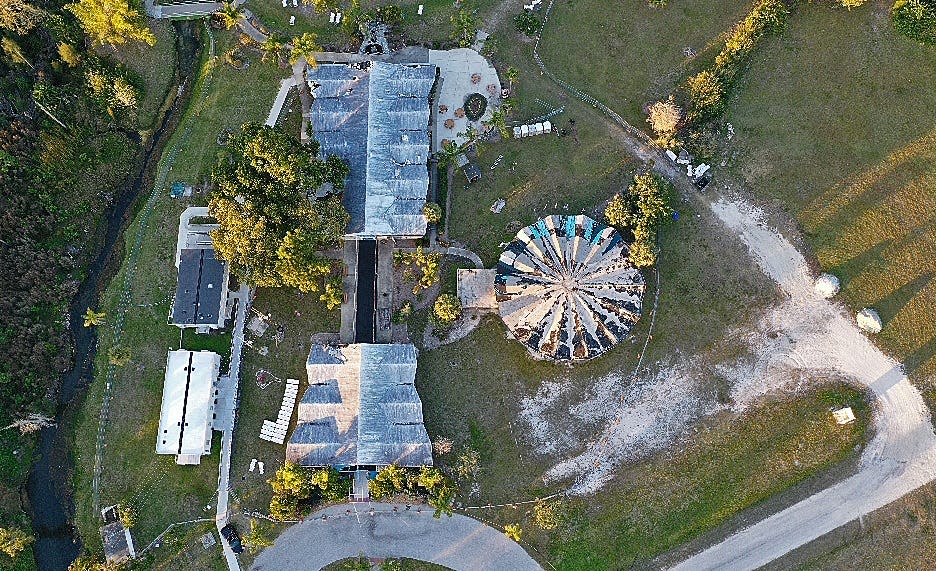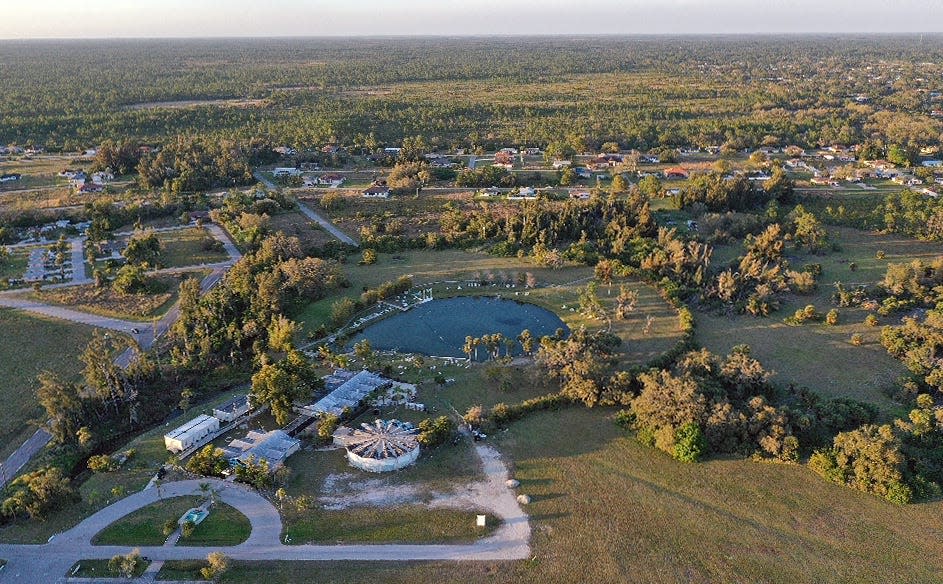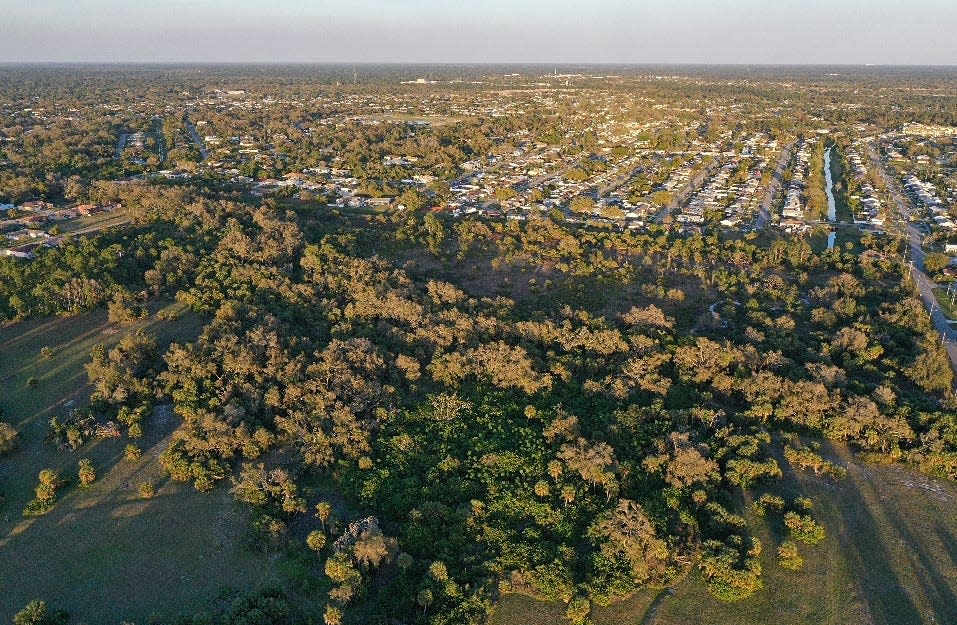North Port commissioners take first step to erase historic Warm Mineral Springs buildings

NORTH PORT – The only three historic buildings in the city of North Port are at least one vote away from the wrecking ball after the City Commission voted 4-1 Tuesday to direct staff for a plan to raze the sales and spa buildings and the cyclorama at Warm Mineral Springs and replace them with one minimalistic structure.
The board later voted unanimously to fast-track a plan to develop a trailhead for the Legacy Trail at the 83-acre park and extend a path north to the North Port Connector to the Legacy Trail, which currently ends near the intersection of Price Boulevard and Calera Street.
Both issues must return to the commission, which leaves open a window of opportunity for people interested in preserving the three buildings to lobby nonprofits or possibly the state of Florida – perhaps through its Florida Forever land acquisition program – preserve the entire park and least the cyclorama, if not the entire historical campus.
Nonetheless, a majority of the commission had no appetite to delay its vote to explore the possibility of working with the state or an outside entity.
“In my heart of hearts, I want the city out of the Warm Mineral Springs business,” said Commissioner Barbara Langdon. “But I don’t think we need to stop our forward movement.

“I want to make sure that Warm Mineral Springs can maintain itself without going to the taxpayers.”
City Manager Jerome Fletcher suggested that members of a vocal majority that opposed the prospect of a public-private partnership developing 61.4-acres of parkland while restoring the three structures should take the lead in contacting the state and area conservation groups.
“The voices we’ve heard from are very well organized,” Fletcher said to Vice Mayor Phil Stokes, who stressed that there’s still an opportunity to contact outside groups. “You should encourage them to do so.”
Why did the board move toward demolishing the buildings?
The board majority is determined to keep any Warm Mineral Springs construction project within the $8.5 million earmarked for the project and are hesitant to commit any additional city tax money at Warm Mineral Springs.
Commissioners also dismissed a suggestion by longtime resident Chuck English to ask city voters in a referendum whether to pump more funds into the project.
That decision likely dooms the preservation of the three buildings believed to be designed by Jack West of the Sarasota School of Architecture that were used to host the Florida Quadricentennial between December 1959 and March 1960.
Once thought to be the Fountain of Youth when it was discovered by explorer Juan Ponce de Leon, Warm Mineral Springs is an hourglass-shaped sinkhole primarily fed by an underground stream that pumps in 20 million gallons of 86 degree water per day.
Bathers believe the waters have healing powers.
The spring itself and a 21.6-acre protection zone was put on the National Register of Historic Places in 1977.
Ironically, the city created its local historical register specifically so the three structures at 12200 San Servando Ave. could be placed on the National Register of Historic Places. They were awarded that status in 2019.
The city staff recommended razing the three buildings, with the fallback position preservation of the cyclorama.
The motion that was approved, with Commissioner Debbie McDowell in dissent, called for staff to determine the cost of demolishing each building – as a group or individually – while preserving portions of the mural in the cyclorama, constructing a basic sales building with inside restrooms and outdoor showers, as well as the cost for site development, parking and extension of water and sewer lines.
Where will that $8.5 million be spent?
A portion of that $8.5 million will already go to the current consultants, Sweet Sparkman Architecture & Interiors and Kimley-Horn and Associates to determine those costs.
Restoration of the cyclorama was projected to cost between $3.5 million and $4.1 million, excluding the design and site construction costs, according to a report by Sweet Sparkman Architecture & Interiors.
That was seen as cost-prohibitive since the commission's primary concern is extension of water and sewer service to the park and construction of an entry building with outdoor showers.
The cost of that water and sewer extension was projected to be $4 million, though it wasn’t completely clear whether that was extending the lines via Trionfo Avenue and then looping back east, or if the connection would then travel south on Ortiz Boulevard – in Sarasota County – and link up with city water and sewer lines along U.S. 41.
A city spokesman later said via email that the work required to serve the park includes an onsite pump station and 4,100 linear feet of force main for wastewater and 6,000 linear feet of water pipe.
It would also include a force main and water main on Ortiz Boulevard, so parcels fronting Ortiz could be able to connect to the pipes.
What is the plan for the 61.4 acres?
The main firm directive staff received was to fast-track a plan to connect Warm Mineral Springs to the Legacy Trail.

That, too, was city staff’s vision for an initial step that could lead to developing that property as a park similar to the 2019 plan crafted by Kimley-Horn.
In March 2022, the cost for that link and accompanying trailhead was projected to be $4.5 million and it is currently in the 2030-34 budget years for sale tax revenue.
The mile long connection is designed but not funded.
Fletcher and Charles Hines, program director for the Gulf Coast Trail with the Trust for Public Land, have already had initial talks.
Hines, also a former member of the Sarasota County Commission, told the Herald-Tribune Tuesday that the segment should be eligible for SunTrail funding.
He added that it should also be considered for county park impact fees – a funding source the City Commission hoped to tap – could be used for the trailhead as well.
Langdon, who at first said the 2019 plan wasn’t feasible to implement because of cost, later suggested that she would welcome a spa of some sort.
“If we could bring in some light development to that property and really make it a destination that we would be proud of as a community, that’s what I’m in favor of,” Langdon said.
That may be tough to pull off without city involvement, given the fact that Stokes and Commissioner Pete Emrich indicated they would never vote to sell a portion of the park, while Emrich indicated he would frown upon even a long-term lease.
Early approval from the public
Members of the public who attended the meeting started the day off by asking the commission to end the quest for private development and follow that 2019 plan as well as the will of those who responded to a public survey last summer that the commission later questioned.
By the time it was clear that the board had already chosen that path, it changed to congratulatory.
“Wow, thank you how cool this is,” said James Strawser, a vocal advocate of preserving the park. “You guys get to be a part of something that is a legacy. I’m inspired right now.”
He went on to champion the importance of the historic structures, with the sales and spa buildings echoing the hourglass shaped depth of the springs, with the cyclorama representing the overhead view of Warm Mineral Springs itself.
Robin San Vicente, who served in a variety of capacities at Warm Mineral Springs through 2009, when it was privately owned, said that proponents of other options to preserve the park may step forward now that the city has veered away from finding a private development partner.
“The simplest methodology is what’s best," San Vincente said. “We need to do what we can do to get the springs in a proper place … and bring in additional activities through ecotourism programs.”
This article originally appeared on Sarasota Herald-Tribune: Too much to save? Historic Warm Mineral Springs buildings may be razed

